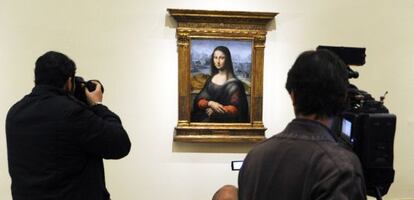The other ‘Mona Lisa’ upends the Prado
Visitors flock to see newly restored copy of Da Vinci portrait


Museums are quiet places – sometimes too quiet. To keep visitors interested, cultural chiefs have the option of coming up with new ways of relating to and seducing the public and the media – to invent news. And the (re)appearance of the Prado’s Mona Lisa is, among many other things, just that: an invented news story. The culmination of that story arrived in room 49 of the Madrid gallery on Wednesday. No sooner were the doors opened to allow the public to see this newly discovered copy of Leonardo da Vinci’s masterpiece with their own eyes, than security staff had to be deployed all around so that visitors didn’t do it any damage.
Prado director Miguel Zugaza witnessed the quiet invasion of room 49 with a mixture of amusement and concern. Five or six rows of people, cameras and cellphones at the ready, crowded in front of the work painted by a Da Vinci apprentice (we still do not know, nor probably will ever know, which one) at the same time as the maestro worked on his original. The excitement began gently deteriorating into a spectacle when security guards entered the scene, banning photos from being taken. Nearby, in the museum gift shop, you could find the first pieces of Mona Lisa merchandising: prints, postcards, coasters, notebooks…
The copy is set to stay on the walls of room 49 until March 13. On that day it will travel to the Louvre, where it will form part of the exhibition Leonardo'sLast Masterpiece: The Sainte Anne, which runs from March 29 to June 25. The Madrid copy will not, however, be exhibited alongside the original during its Paris stay. Upon its return, it will take up residence in room 56b of the Prado.
The history of the restoration is fascinating, not just “because of the information it will provide about Leonardo da Vinci’s working methods, of which we are lacking data,” says Ana González Mozo, author of the technical study, but also for some of the conclusions obtained. The most fundamental of these, of which Prado restorers are evidently proud, is the relative simultaneity between the Leonardo original and the copy. “The work has highlighted that the painting was made in parallel with the original portrait,” says the report. This is the first time there has been proof, say gallery restorers, that a copy of the Mona Lisa was made “live.”
To carry out the four-month restoration, Almudena Sánchez cleared away the oxidized varnish, did away with the horrendous black paint covering the background landscape (added in the 18th century, according to the report) and the veil and hair of subject Lisa Gherardini on the left side of the portrait, and finally reinstated the colors that returned the copy to its original state. “It opened a window that had been closed for two centuries,” she says.







































